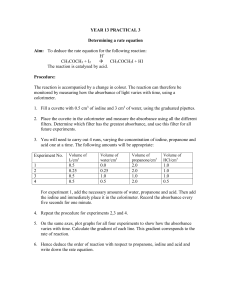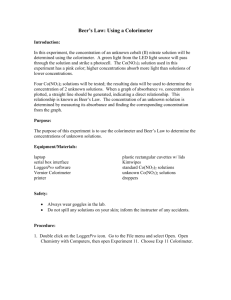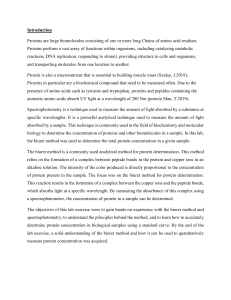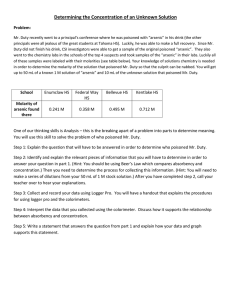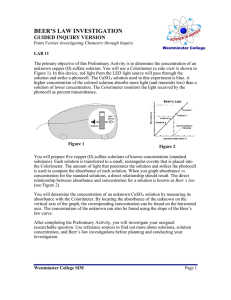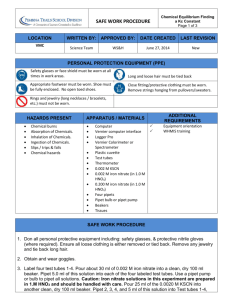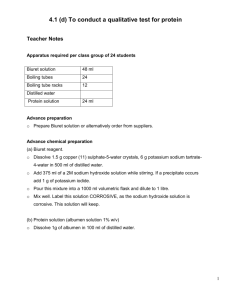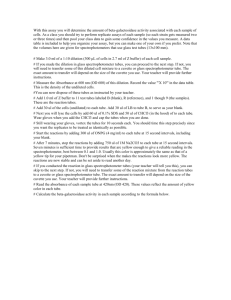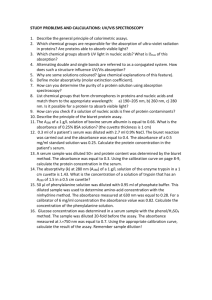Investigating Protein Concentration with a Quantitative Biuret Test
advertisement
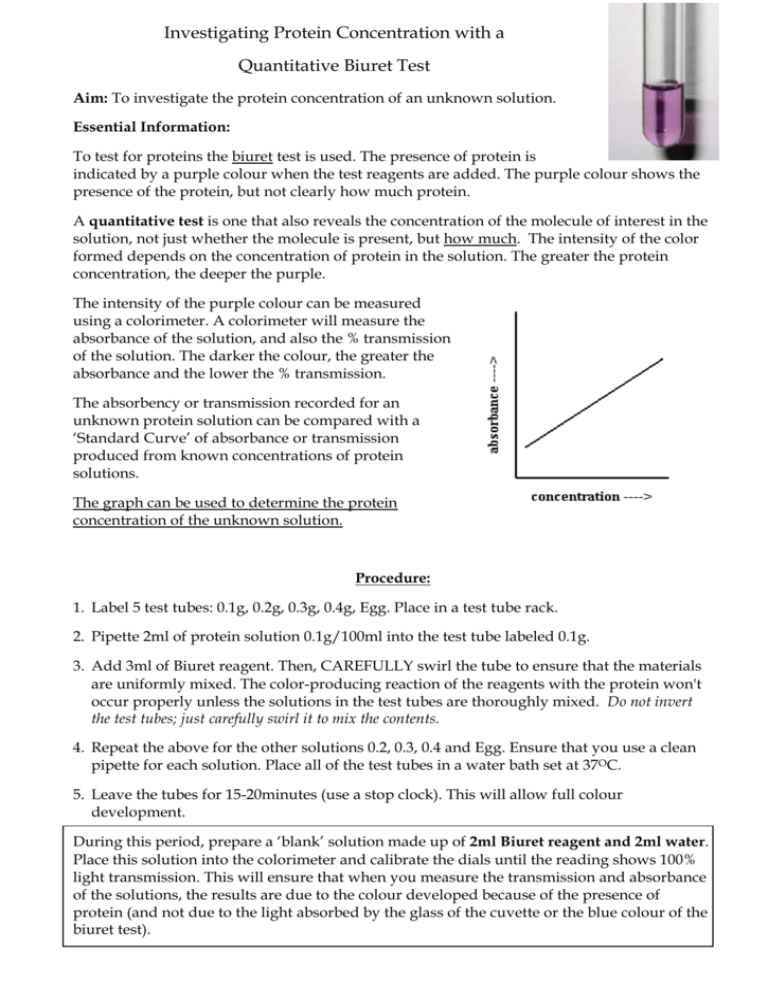
Investigating Protein Concentration with a Quantitative Biuret Test Aim: To investigate the protein concentration of an unknown solution. Essential Information: To test for proteins the biuret test is used. The presence of protein is indicated by a purple colour when the test reagents are added. The purple colour shows the presence of the protein, but not clearly how much protein. A quantitative test is one that also reveals the concentration of the molecule of interest in the solution, not just whether the molecule is present, but how much. The intensity of the color formed depends on the concentration of protein in the solution. The greater the protein concentration, the deeper the purple. The intensity of the purple colour can be measured using a colorimeter. A colorimeter will measure the absorbance of the solution, and also the % transmission of the solution. The darker the colour, the greater the absorbance and the lower the % transmission. The absorbency or transmission recorded for an unknown protein solution can be compared with a ‘Standard Curve’ of absorbance or transmission produced from known concentrations of protein solutions. The graph can be used to determine the protein concentration of the unknown solution. Procedure: 1. Label 5 test tubes: 0.1g, 0.2g, 0.3g, 0.4g, Egg. Place in a test tube rack. 2. Pipette 2ml of protein solution 0.1g/100ml into the test tube labeled 0.1g. 3. Add 3ml of Biuret reagent. Then, CAREFULLY swirl the tube to ensure that the materials are uniformly mixed. The color-producing reaction of the reagents with the protein won't occur properly unless the solutions in the test tubes are thoroughly mixed. Do not invert the test tubes; just carefully swirl it to mix the contents. 4. Repeat the above for the other solutions 0.2, 0.3, 0.4 and Egg. Ensure that you use a clean pipette for each solution. Place all of the test tubes in a water bath set at 37OC. 5. Leave the tubes for 15-20minutes (use a stop clock). This will allow full colour development. During this period, prepare a ‘blank’ solution made up of 2ml Biuret reagent and 2ml water. Place this solution into the colorimeter and calibrate the dials until the reading shows 100% light transmission. This will ensure that when you measure the transmission and absorbance of the solutions, the results are due to the colour developed because of the presence of protein (and not due to the light absorbed by the glass of the cuvette or the blue colour of the biuret test). 6. After 15-20 minutes, ensure that YOUR blank has been used to standardize the colorimeter, then fill a cuvette with solution from tube 0.1g. Place the cuvette in the colorimeter and measure the % transmission and absorbance. Record the % absorbance in a suitable results table. Return the solution to the test tube (you may need it again!) 7. Repeat for the other test solutions and record into the table, ensuring that you return each solution to its original tube. PRECAUTION: thoroughly rinse the cuvette between each use using a bottle of water. It is also important that you do not put your solution into the cuvette until you are ready to take the reading. 8. Draw a calibration graph of absorbance (y axis) against protein concentration (g/100ml) for the results for 0.1, 0.2, 0.3 and 0.4g/100ml. 9. Use the curve you have drawn to calculate the protein concentration of a raw egg. Written work to be completed for this practical: 1) The aim of the experiment (1) 2) A description of the experiment, focusing on an explanation of the use of the colorimeter and standard curve to determine the protein concentration of the raw egg (a couple of paragraphs- a write up of the full method is not required!). Don’t forget to include the overall result that you found for the protein content of the egg. (5) 3) A well set out results table with a title, column headings, and results presented clearly. (standard of presentation is important here). Your table will need to include all of your readings and a column for the interpretation of the results- i.e. the protein concentration. (7) 4) Answer the following questions: a) What precautions did you take during this experiment and why were they necessary? (A precaution is a step within the procedure that will reduce the opportunity for errors and inaccuracies to occur) (3) b) What are the limitations of this experiment? How can anomalous results be explained? (2) c) Explain the advantages of using a quantitative Biuret test rather than a qualitative biuret test (which just records whether protein is present using the purple colour). (2)



